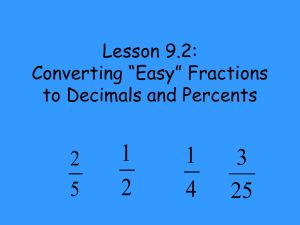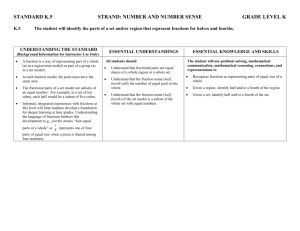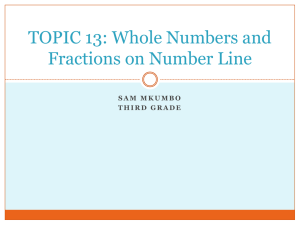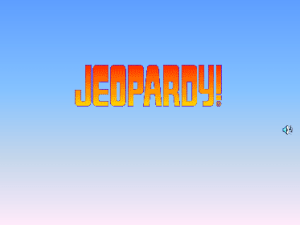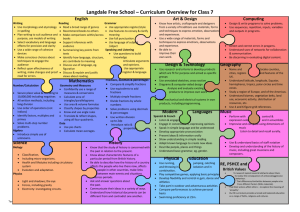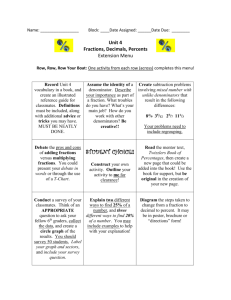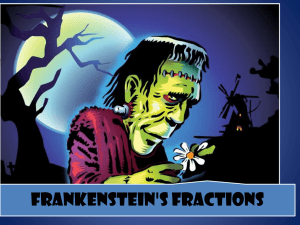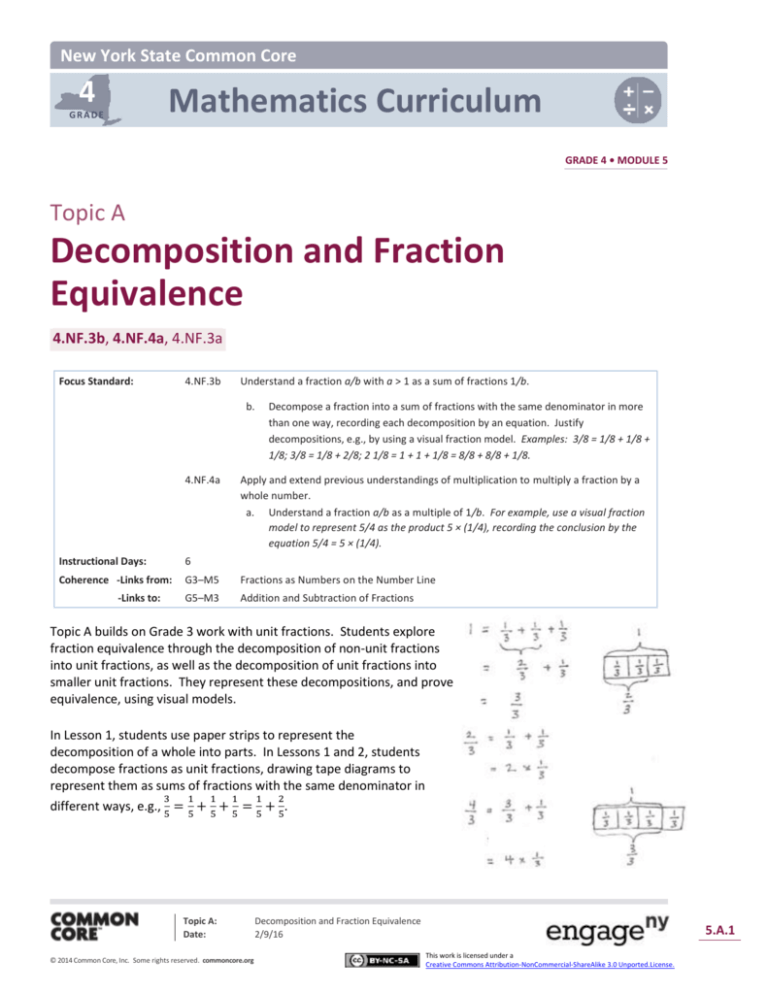
New York State Common Core
4
Mathematics Curriculum
GRADE
GRADE 4 • MODULE 5
Topic A
Decomposition and Fraction
Equivalence
4.NF.3b, 4.NF.4a, 4.NF.3a
Focus Standard:
4.NF.3b
Understand a fraction a/b with a > 1 as a sum of fractions 1/b.
b.
4.NF.4a
Decompose a fraction into a sum of fractions with the same denominator in more
than one way, recording each decomposition by an equation. Justify
decompositions, e.g., by using a visual fraction model. Examples: 3/8 = 1/8 + 1/8 +
1/8; 3/8 = 1/8 + 2/8; 2 1/8 = 1 + 1 + 1/8 = 8/8 + 8/8 + 1/8.
Apply and extend previous understandings of multiplication to multiply a fraction by a
whole number.
a.
Understand a fraction a/b as a multiple of 1/b. For example, use a visual fraction
model to represent 5/4 as the product 5 × (1/4), recording the conclusion by the
equation 5/4 = 5 × (1/4).
Instructional Days:
6
Coherence -Links from:
G3–M5
Fractions as Numbers on the Number Line
G5–M3
Addition and Subtraction of Fractions
-Links to:
Topic A builds on Grade 3 work with unit fractions. Students explore
fraction equivalence through the decomposition of non-unit fractions
into unit fractions, as well as the decomposition of unit fractions into
smaller unit fractions. They represent these decompositions, and prove
equivalence, using visual models.
In Lesson 1, students use paper strips to represent the
decomposition of a whole into parts. In Lessons 1 and 2, students
decompose fractions as unit fractions, drawing tape diagrams to
represent them as sums of fractions with the same denominator in
3
1
1
1
1
2
different ways, e.g., = + + = + .
5
5
5
5
Topic A:
Date:
© 2014 Common Core, Inc. Some rights reserved. commoncore.org
5
5
Decomposition and Fraction Equivalence
2/9/16
5.A.1
This work is licensed under a
Creative Commons Attribution-NonCommercial-ShareAlike 3.0 Unported.License.
NYS COMMON CORE MATHEMATICS CURRICULUM
Topic A 4 5
In Lesson 3, students see that representing a fraction as the repeated addition of a unit fraction is the same
as multiplying that unit fraction by a whole number. This is already a familiar fact in other contexts. An
example is as follows:
3 bananas = 1 banana + 1 banana + 1 banana = 3 × 1 banana,
3 twos = 2 + 2 + 2 = 3 × 2
3 fourths = 1 fourth + 1 fourth + 1 fourth = 3 × 1 fourth,
3 1 1 1
= + +
4 4 4 4
=3×
1
4
By introducing multiplication as a record of the
decomposition of a fraction early in the module,
students are accustomed to the notation by the time
they work with more complex problems in Topic G.
Students continue with decomposition in Lesson 4,
where they use tape diagrams to represent fractions,
1 1
2
e.g., 2 , 3 , and 3 , as the sum of smaller unit fractions.
Students record the results as a number sentence, e.g.,
1 1 1
1 1
1 1
4
= + =( + )+( + )= .
2 4 4
8 8
8 8
8
In Lesson 5, this idea is further investigated as students represent the decomposition of unit fractions in area
models. In Lesson 6, students use the area model for a second day, this time to represent fractions with
different numerators. They explain why two different fractions represent the same portion of a whole.
Topic A:
Date:
© 2014 Common Core, Inc. Some rights reserved. commoncore.org
Decomposition and Fraction Equivalence
2/9/16
5.A.2
This work is licensed under a
Creative Commons Attribution-NonCommercial-ShareAlike 3.0 Unported.License.
Topic A 4 5
NYS COMMON CORE MATHEMATICS CURRICULUM
A Teaching Sequence Toward Mastery of Decomposition and Fraction Equivalence
Objective 1: Decompose fractions as a sum of unit fractions using tape diagrams.
(Lessons 1–2)
Objective 2: Decompose non-unit fractions and represent them as a whole number times a unit fraction
using tape diagrams.
(Lesson 3)
Objective 3: Decompose fractions into sums of smaller unit fractions using tape diagrams.
(Lesson 4)
Objective 4: Decompose unit fractions using area models to show equivalence.
(Lesson 5)
Objective 5: Decompose fractions using area models to show equivalence.
(Lesson 6)
Topic A:
Date:
© 2014 Common Core, Inc. Some rights reserved. commoncore.org
Decomposition and Fraction Equivalence
2/9/16
5.A.3
This work is licensed under a
Creative Commons Attribution-NonCommercial-ShareAlike 3.0 Unported.License.

